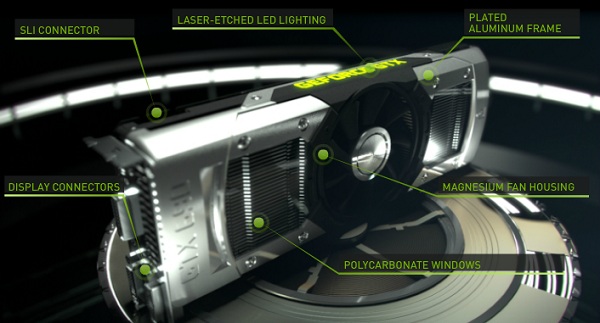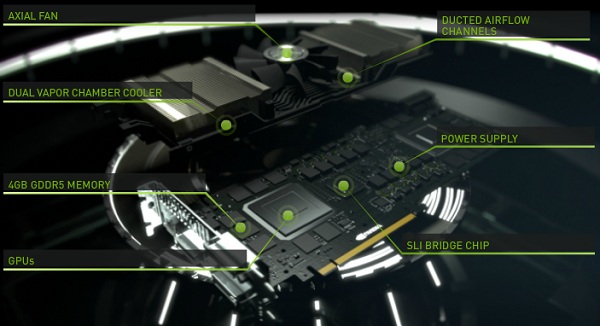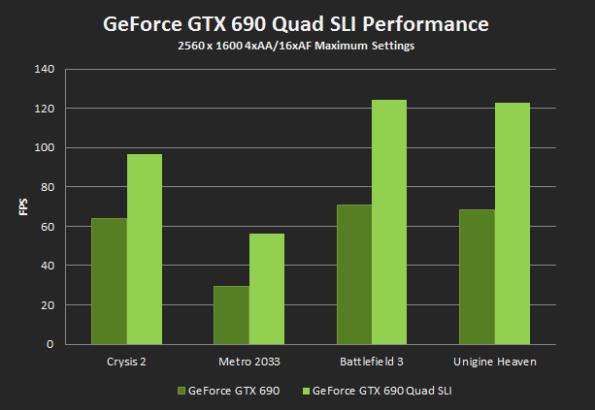It was only last month that we had the pleasure of bringing you news of the first NVIDIA Kepler GPU, the GTX 680, which blew away AMD's Radeon HD 7970 in both overall performance, bang-for-buck and bang-for-watt in our benchmarks.

Following in the wake of the 680's success, NVIDIA has today announced, for release on May 3rd, the GeForce GTX 690, which features two of the same, GK104 GPU dies, featured in the 680, along with double the RAM, making this the first consumer 4GB card of the current generation.

NVIDIA has held nothing back in the stock design of the 690, with the card featuring a cast aluminium frame with chromium plating, a magnesium fan housing, for superior noise and thermal properties and, laser-etched LED lighting, making this one of the best looking cards around. The card features two vapour cooling chambers, one per GPU, joined by a heat-spreader with airflow channels running under the central fan, with NVIDIA claiming both superior cooling and noise performance.
| GTX 690 | GTX 680 | GTX 590 | GTX 580 | |
| Stream Processors | 2 x 1536 | 1536 | 2 x 512 | 512 |
| Texture Units | 2 x 128 | 128 | 2 x 64 | 64 |
| ROPs | 2 x 32 | 32 | 2 x 48 | 48 |
| Core Clock | 915MHz | 1006MHz | 607MHz | 772MHz |
| Shader Clock | N/A | N/A | 1214MHz | 1544MHz |
| Boost Clock | 1019MHz | 1058MHz | N/A | N/A |
| Memory Clock | 6.008GHz GDDR5 | 6.008GHz GDDR5 | 3.414GHz GDDR5 | 4.008GHz GDDR5 |
| Memory Bus Width | 2 x 256-bit | 256-bit | 2 x 384-bit | 384-bit |
| VRAM | 2 x 2GB | 2GB | 2 x 1.5GB | 1.5GB |
| FP64 | 1/24 FP32 | 1/24 FP32 | 1/8 FP32 | 1/8 FP32 |
| TDP | 300W | 195W | 375W | 244W |
| Transistor Count | 2 x 3.5B | 3.5B | 2 x 3B | 3B |
| Manufacturing Process | TSMC 28nm | TSMC 28nm | TSMC 40nm | TSMC 40nm |
| Launch Price | $999 (£799+?) | $499 (£430) | $699 (£569) | $499 (£399) |
It's when looking closely at the specifications for the 690, that we can tell it's going to be one serious contender. Typically, when two GPUs are placed on the same PCB, die and memory clock speeds must be lowered in order to achieve an acceptable thermal output, given that components are sharing the same cooling solution; leading to inferior performance when compared against a like-for-like SLI setup.
You can see Kepler's excellent power and thermal efficiency shine through here; when comparing the previous generation Fermi GTX 580, against its dual-GPU 590 counterpart, you can see a difference in GPU clock speed of 27 per cent, however, in Kepler, the difference has been reduced to only 10 per cent and memory clock speeds have, unlike with Fermi, remained the same. What's more is the 690 boasts a greater Boost Clock margin than the 680, resulting in a Boost Clock difference of only 2.8 per cent. All this with a TDP of only 300 watts, significantly lower than the GTX 590's 375 watts.
Likewise, one of our concerns for the 680 was the limited memory bandwidth, which we felt acted as a bottleneck under certain loads. Whilst a dual-GPU configuration doesn't truly offer twice the effective bandwidth, we suspect this will go some way to aiding performance.

NVIDIA has produced its own set of initial benchmarks and though we'd certainly like to run our own before drawing any real conclusions, initial results look promising indeed, with the 690 featuring an average performance gain of 75 per cent over the 680, which, at 300 watts, would be a significant improvement in bang-for-watt.

Likewise, the 690 can be paired up with a second card, resulting effectively in a quad-SLI setup. Despite typically diminishing efficiency in a multi-GPU scenario, the 690 manages to achieve anywhere in the range of a 50 to 90 per cent performance gain; certainly nothing to quibble over.
Whilst we're impressed by initial claims, at a price of $999 (£699+?), the GeForce GTX 690 is really going to have to deliver in our in-house benchmarks and, even then, won't be for the light-of-wallet.













